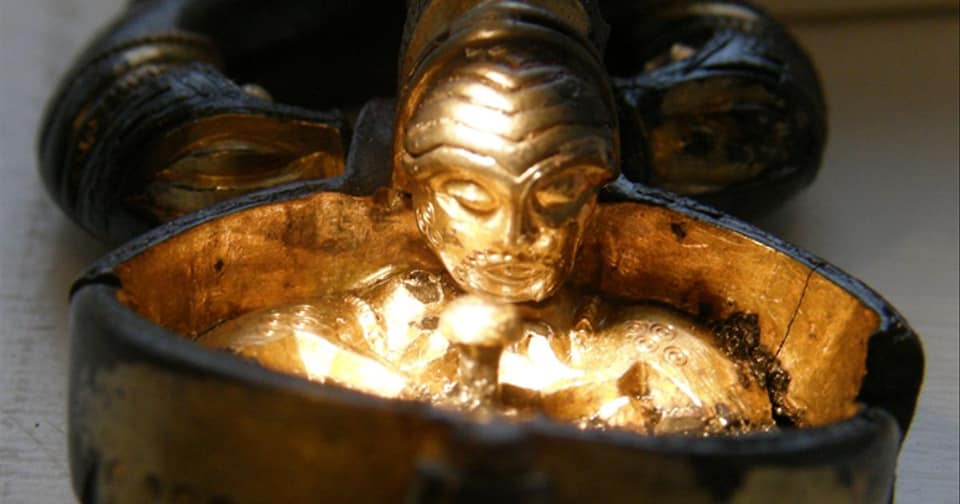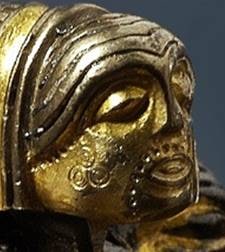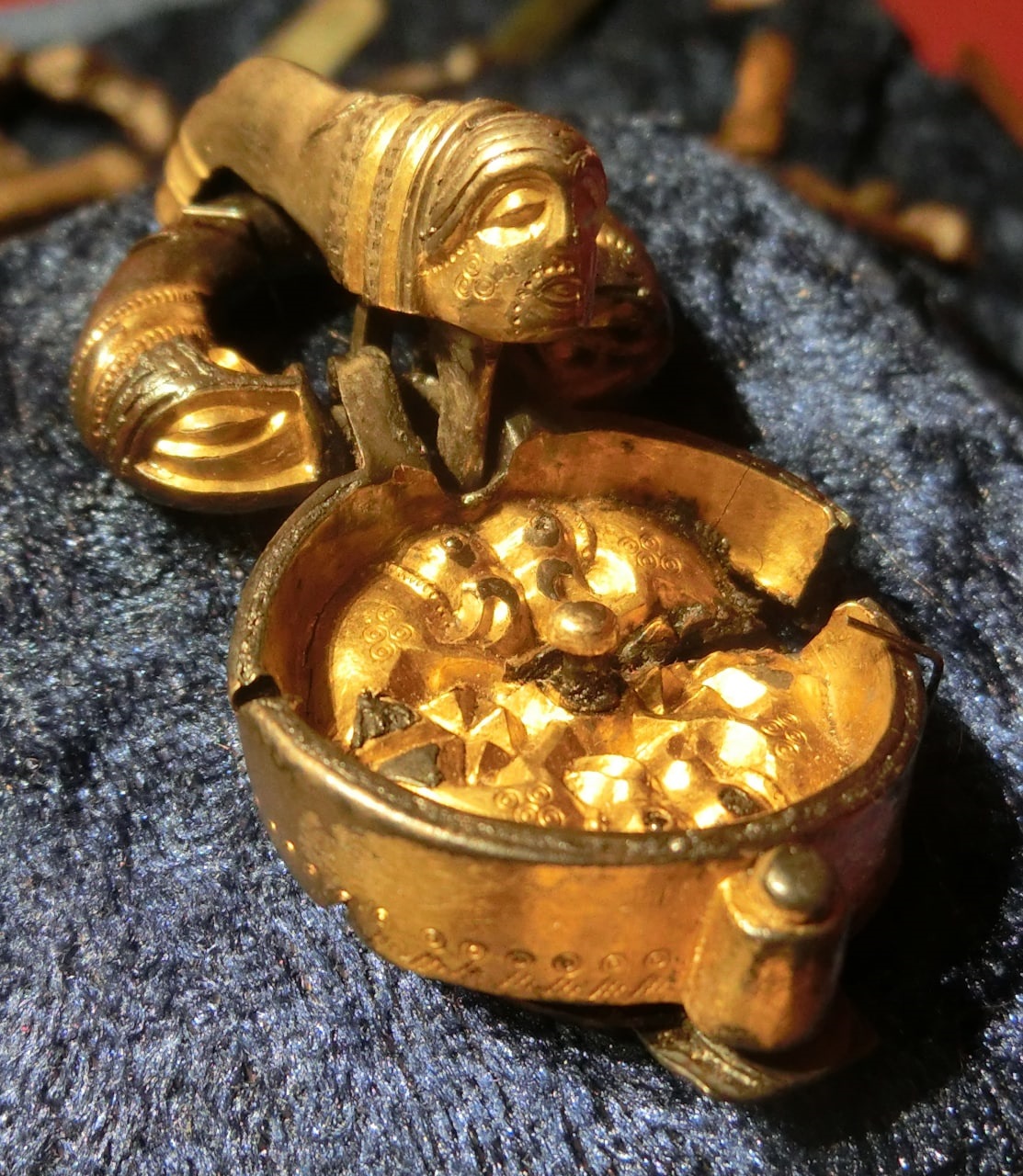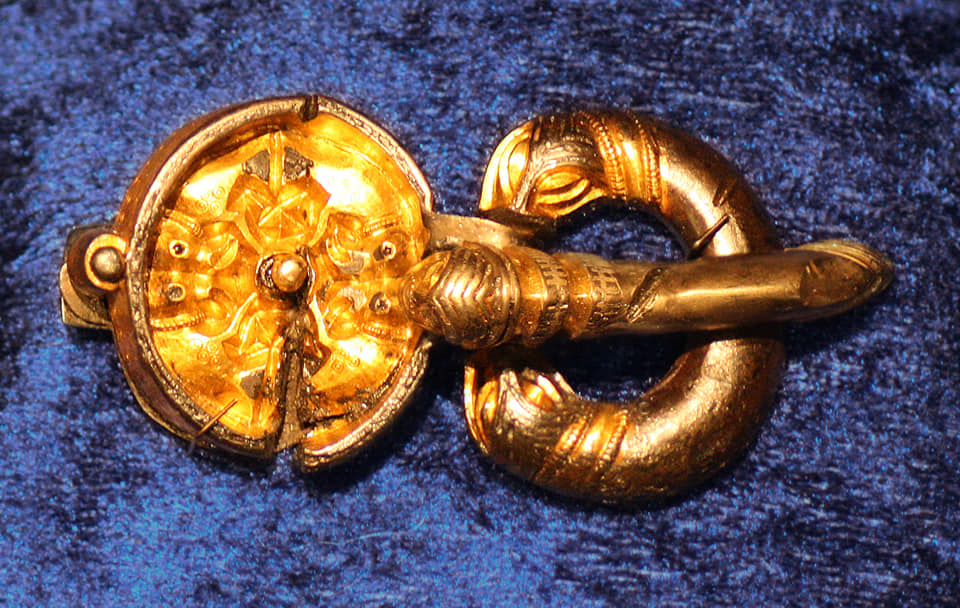
|
In the bogs of Finnestorp in Västergötland,
Sweden, offerings of weapons and other military
equipment took place there following victorious battles
on a few occasions over the centuries. Since the
year 2000, a large project with multiple excavations,
research and publications, has focused on the offerings
of military equipment at Finnestorp, Västergötland, in
south-western Sweden (Nordqvist 2017).
The offering site is situated on the border between the
parishes of Larv and Trävattna. The site is located in a
central part of the province in an extensive wooded
wetland, forming a natural border between two rich
agrarian plains, the Skara Plain to the west and
Falbygden to the east. The Finnestorp site is
characterised by an abundance of Migration Period finds.
At the site in 2004, a late 5th century buckle, made of
gilded silver, was discovered among the war-booty
deposited there.
On the faceplate at the end of the prong is
depicted the head of a man, mouth open, apparently
poised to drink.
Each time the prong is lifted, the man's mouth touchs the
“water” in the basin below. Bengt Nordqvist, the
chief archaeologist on the dig, has convincingly
interpreted the scene as Odin drinking from Mimir's
well, as he hung by his feet from the Ash Yggdrassil's,
(Hávamál 138-141,
C. Larrington tr.), as demonstrated in
a series of articles on Odin by Jere Fleck in the
1970s.
|
 |
| |
|
|
|
| |
Veit
ek, at ek hekk
vindga meiði á
nætr allar níu,
geiri undaðr
ok gefinn Óðni,
sjalfr sjalfum mér,
á þeim meiði,
er manngi veit
hvers af rótum renn. |
138.
I know that I hung
on a windswept tree
nine long nights,
wounded with a spear,
dedicated to Odin,
myself to myself,
on that tree of which
no man knows
from where its roots run |
|
| |
|
|
|
| |
Við hleifi mik sældu
né við hornigi;
nýsta ek niðr,
nam ek upp rúnar,
æpandi nam,
fell ek aftr þaðan.
|
139. With no bread did they refresh me
nor a drink from a horn,
downwards I peered;
I took up the runes,
screaming I took them,
then I fell back from there. |
|
| |
|
|
|
| |
Fimbulljóð níu
nam ek af inum frægja syni
Bölþorns, Bestlu föður,
ok ek drykk of gat
ins dýra mjaðar,
ausinn Óðreri.
|
140. Nine mighty spells
I learnt from [Mimir], the famous son of
Bolthor, Bestla's father,*
and I got a drink of
the precious mead,
I, soaked from Odrerir. |
|
| |
*Bestla: Odin's mother;
Bestla's father, Bolthor: Odin's maternal
grandfather, Ymir-Aurgelmir; his son,
Mimir (cp. Vafþrúðnismál 32), is
therefore Odin's mother's brother, a
particularly close relationship in Germanic
society (Tacitus, Germania ch. 20).
|
|
| |
Þá nam ek frævask
ok fróðr vera
ok vaxa ok vel hafask,
orð mér af orði
orðs leitaði,
verk mér af verki
verks leitaði. |
141. Then I began to quicken
and be wise,
and to grow and to prosper;
one word from another word
found a word for me,
one deed from another deed
found a deed for me.
|
|
 |
|
|
The face bears a moustache and tattoos, forming a line
from the eye, and three circles at each cheek consisting
of two concentric circles each. The right eye may be
blind. Around the well we find small triangles
with a circle at the top. We also find these circles in
the “water” of the well. This ornamentational stamp is
also found on horse tack and other items recovered from
the bogs at Finnestorp.
Decorative mounts, clasps and pendants are some of the
different forms of finds. Other categories include sword
pommels, scabbards and beads, saddle and strap mounts,
as well as parts of bridles. There are large quantities
of unburnt horse bones. Most of the offering sites are
located on elevations in the wetland, which may have
been small islands when the offerings took place.
Although single finds are found in low lying land, they
are few and sparsely spread over the area. Remains of
firepits are found on three of the four islands in the
wetland. All placed near the water's edge, these
firepits are small, irregular, shallow and diffuse.
|
|
|
 |
|
|
 |
The sacrificial site at Finnestorp is closely akin to
similar deposits made in lakes or bogs (“bog finds”),
known from Denmark, southern Sweden and Schleswig.
Corresponding finds of a similar character are known in
the Baltic States and in Poland. Often described as war
booty, in reality, they mainly contain military
equipment. The majority of the offerings consist of
equipment carried by warriors and their war-horses.
Several mounts are punch-decorated in high-quality
Sösdala style. About half of the objects recovered
at Finnestorp are horse tack. Among the many bones are
primarily those of horses, but humans, pigs and sheep
are also represented. At Finnestorp, objects have
been found made of gold, silver, bronze, iron and wood.
Wooden artefacts include poles cut with an axe.
According to Bengt Nordqvist, the find material is
roughly subdivided into three categories.
1) Personal equipment: finger-ring in
gold, clasps, belt mounts (buckles, strap ends), belt
bag (mini-buckle and pendant), etc. In all over 100
objects belong to this category.
2) Weapons: sword (blade, pommel, hilt), sword scabbard
(chape and mouthpiece), mounts of sword belt, lance and
spear heads, arrow heads and possibly a throwing axe. A
total of just under 200 objects belong to this category.
3) Horse tack: mounts of saddles and bridles. Decorative
mounts, strap junctions and strap ends come from
headstalls. Mounts including rein chains are from the
snaffle. Saddle remains are mounts and rings with
staples. Probably all of the pelta-shaped pendants
belong to saddles. In all nearly 300 objects belong to
this category.
Most finds were deposited between the late 2nd century
and the end of the 5th century. Currently, these
sacrifices of military gear are interpreted as votive
offerings made in sacred lakes or bogs after a
victorious battle, (Worsaae 1865:65ff.).
This is a setting that followers of Odin would
have known well. |
Information compiled from
published research by
Bengt Nordqvist & Troels Brandt |

|